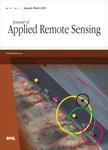版权所有:内蒙古大学图书馆 技术提供:维普资讯• 智图
内蒙古自治区呼和浩特市赛罕区大学西街235号 邮编: 010021

作者机构:Beijing Normal Univ Sch Artificial Intelligence Beijing Peoples R China Univ North Carolina Chapel Hill Dept Radiol Chapel Hill NC USA BRIC Chapel Hill NC USA
出 版 物:《JOURNAL OF APPLIED REMOTE SENSING》 (J. Appl. Remote Sens.)
年 卷 期:2020年第14卷第4期
核心收录:
学科分类:0830[工学-环境科学与工程(可授工学、理学、农学学位)] 1002[医学-临床医学] 070207[理学-光学] 07[理学] 08[工学] 0816[工学-测绘科学与技术] 0803[工学-光学工程] 0702[理学-物理学]
基 金:National Natural Science Foundation of China
主 题:hyperspectral unmixing autoencoder network deep learning L-1/2 regularizer minimum distance constraint
摘 要:Hyperspectral unmixing is an important task in the analyses and applications of hyperspectral images. Recently, the autoencoder network has been intensively studied to unmix hyperspectral image, recovering the material signatures and their corresponding abundance maps from the hyperspectral pixels. However, the autoencoder network cannot get a unique solution since the loss function is nonconvex. In addition, the data often contain a lot of noise. To address these problems, we propose an autoencoder network, referred to as MDC-SAE, that introduces two different constraints to optimize the spectral unmixing problem. Specifically, we adopt the L-1/2 norm regularizer to constrict the abundance vectors, making them sparse. At the same time, we apply the minimum distance constraint on the endmember matrix to push each endmember toward its centroid. We evaluate our method on both synthetic and real data sets, and experimental results demonstrate that the proposed method can achieve the desired solutions and outperforms several state of the art methods. (C) 2020 Society of Photo-Optical Instrumentation Engineers (SPIE)